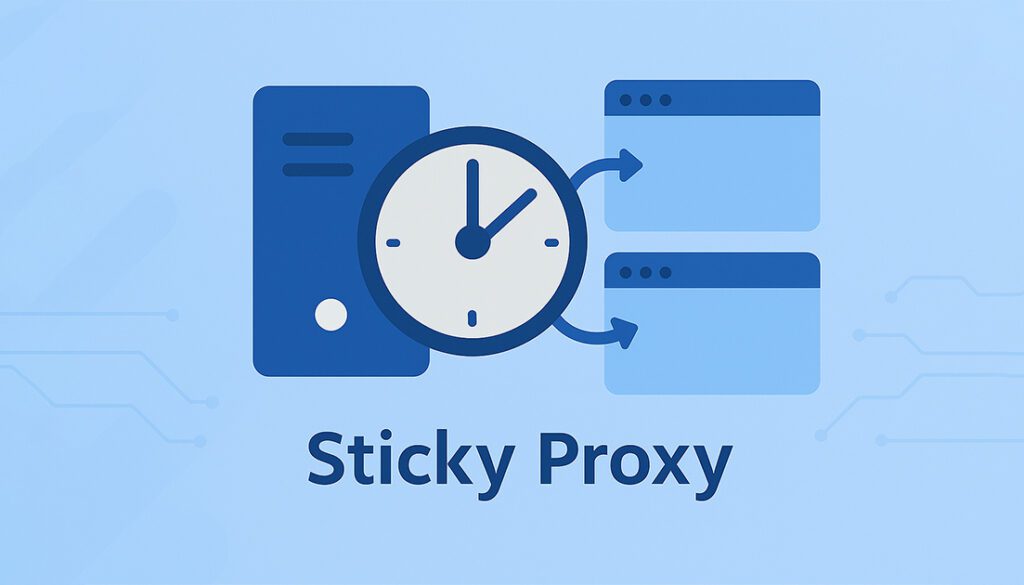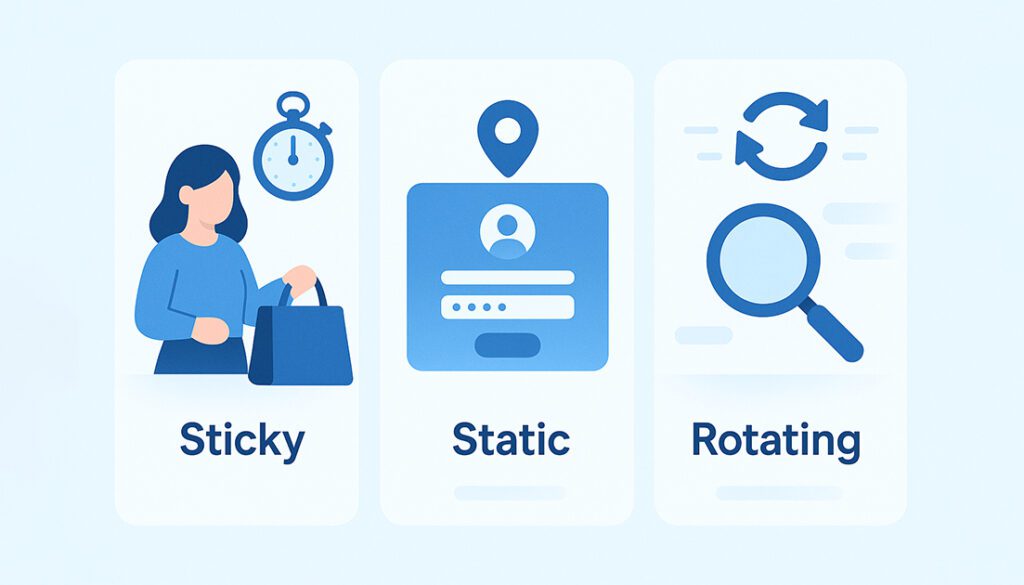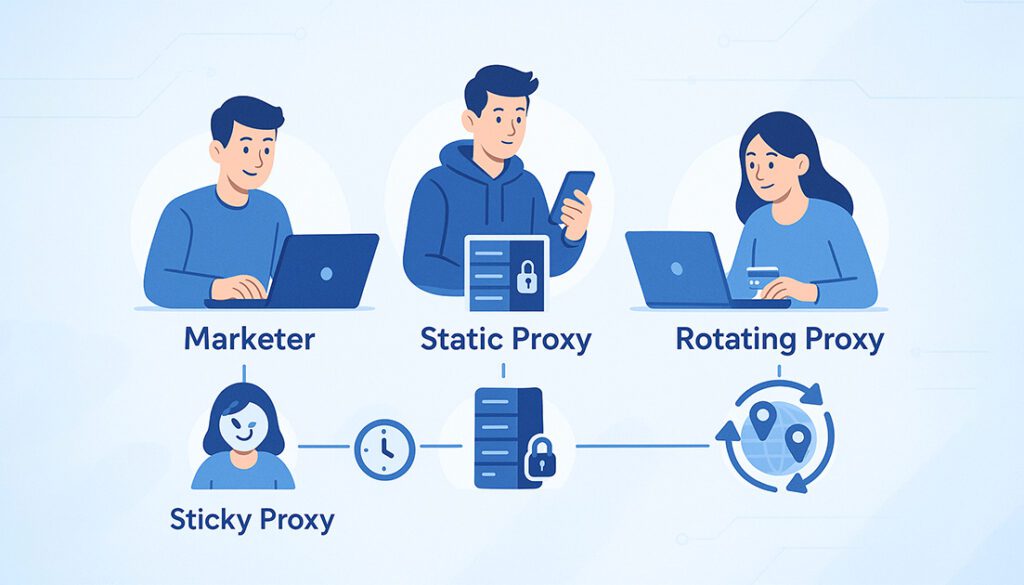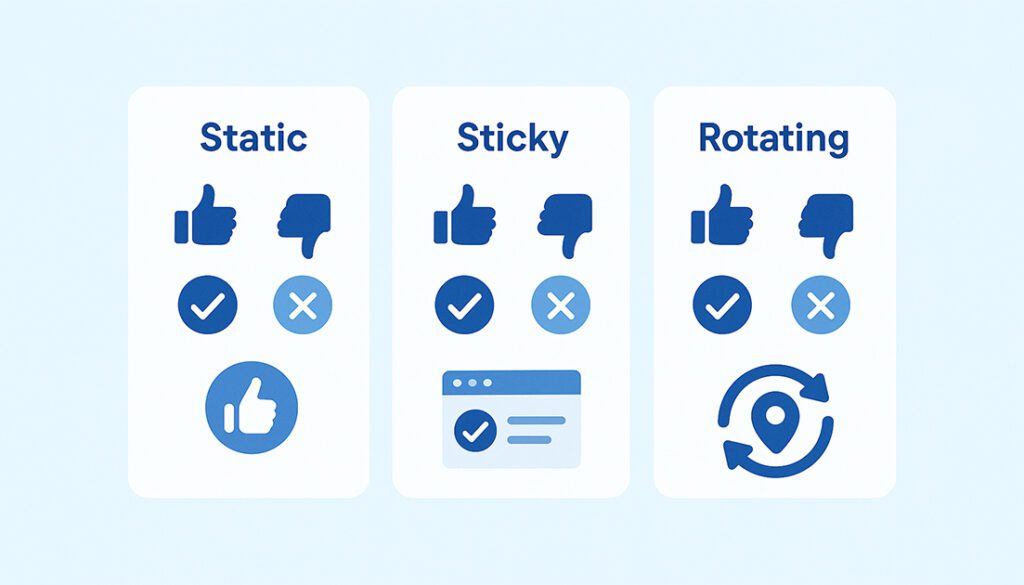Choosing the right proxy type can be tricky, especially when you’re deciding between sticky, static, and rotating proxies. These terms may sound similar, but they serve very different purposes. In this guide, we’ll compare Sticky vs Static vs Rotating Proxies to help you understand how they work and when to use each one.
Each proxy type serves a different purpose. Some are better for scraping data without getting blocked, while others are designed for long sessions or account management. In this guide, we’ll break down Sticky vs Static vs Rotating Proxies, explain how each one works, and help you choose the best option based on real-world use cases.
If you’re just getting started, check out our beginner-friendly guide on what a proxy server does.
What Are Static Proxies?

A static proxy provides you with a fixed IP address that doesn’t change, unless you manually replace it. It’s like having a stable digital identity.
🔹 Key traits of static proxies:
- ✅ One consistent IP address
- ✅ Usually datacenter or ISP-based
- ✅ High stability and uptime
🔹 Best use cases:
- Managing multiple accounts
- Logging into services that flag IP changes
- Running long-term automation tools
If you need a trusted, persistent IP for sensitive tasks, static proxies are your best bet.
📍 Static Proxy Overview
- One fixed IP address that never changes
- Ideal for login stability and account management
- Usually sourced from datacenter or ISP ranges
What Are Sticky Proxies?

Sticky proxies keep the same IP for a short time (usually 5 to 30 minutes), allowing you to maintain session stability, but only temporarily.
🔹 How they work:
- Your IP “sticks” for a fixed time or number of requests
- Often used with residential or mobile IP pools
🔹 Best use cases:
- Web scraping across multiple pages
- Form submissions and cart processes
- Session-based data gathering
Sticky proxies strike a balance between rotating flexibility and static stability, without full ownership of the IP.
🧲 Sticky Proxy Overview
- Same IP retained for a few minutes per session
- Balances rotation with session stability
- Best for scraping or form submission tasks
What Are Rotating Proxies?

Rotating proxies assign you a new IP for every request or after a short interval. They’re perfect for tasks that require scale and stealth.
🔹 How they work:
- Pull from a large IP pool (residential, mobile, or datacenter)
- Rotate automatically per request or on a schedule
🔹 Best use cases:
- Scraping search engine results
- Ad verification and price monitoring
- Avoiding bans or CAPTCHAs
Rotating proxies offer the highest level of anonymity, but they’re not ideal when you need to maintain login sessions or handle cookies.
🔄 Rotating Proxy Overview
- New IP address for each request or short interval
- Great for large-scale scraping or ad verification
- Less ideal for session-based logins
We also reviewed top services offering high-quality rotating proxies in our Bright Data Proxy Review and SOAX Proxy Review.
Sticky vs Static vs Rotating – Key Differences

Choosing between sticky, static, and rotating proxies depends on your session needs, anonymity level, and task type. Here’s how they compare across the most important factors:
| Feature | Static Proxy | Sticky Proxy | Rotating Proxy |
|---|---|---|---|
| IP Assignment | Permanent (Fixed IP) | Temporary (Fixed per session) | Changes per request or interval |
| Session Stability | Full | Short-Term | None |
| Best Use Cases | Account logins, automation, long-term access | Scraping with sessions, carts, navigation | High-volume scraping, SEO, price tracking |
| Anonymity Level | Medium | High | Very High |
| IP Source | Datacenter / ISP | Residential / Mobile | Mixed Pools (High volume) |
Choosing the right proxy is all about matching it to your task’s needs. Consider speed, cost, IP consistency, and privacy when making your choice.
Need to compare proxies with other tools? Read our deep dive into proxy vs VPN and firewall vs proxy vs VPN for more context.
When to Use Each Proxy Type
Each proxy type is built for a specific task. Use the guide below to match the right proxy with the right job, whether you need stability, stealth, or scale.
📍 Use Static Proxies When
- You need a fixed IP that doesn’t change
- You’re managing accounts or logging in repeatedly
- You want consistent performance and geolocation
🧲 Use Sticky Proxies When
- You need session consistency for 5–30 minutes
- You’re scraping websites with multiple steps/pages
- You want to avoid rotation mid-process
🔄 Use Rotating Proxies When
- You’re collecting data at large scale
- You want maximum anonymity and ban protection
- You don’t need long sessions or logins
Real-World Use Cases

Still not sure which proxy to use? Let’s break it down with real-world scenarios where each type shines. These examples show how businesses and individuals apply proxies in practice.
📍 Static Proxies
- Managing e-commerce store dashboards
- Accessing IP-restricted platforms securely
- Running bots that require a trusted, stable IP
🧲 Sticky Proxies
- Scraping product listings across paginated pages
- Adding items to cart before bulk checkouts
- Session-based automation (e.g., form fillers)
🔄 Rotating Proxies
- Scraping Google search or Amazon data at scale
- Bypassing IP rate limits on travel/retail sites
- Running SEO tools or ad verification systems
Learn how proxy types stack up against NAT and gateways in enterprise environments.
Pros and Cons of Each Proxy Type

Each proxy type has its strengths and trade-offs. Here’s a clear breakdown to help you decide based on your specific goals.
📍 Static Proxy
- ✅ High stability for logins and sessions
- ✅ Ideal for account-based platforms
- ❌ Easier to detect and block
- ❌ Fewer IPs mean lower anonymity
🔁 Sticky Proxy
- ✅ Keeps the same IP during sessions
- ✅ Useful for multi-step scraping tasks
- ❌ IPs still expire after session limit
- ❌ Not suitable for persistent identity
🔄 Rotating Proxy
- ✅ High anonymity with frequent IP changes
- ✅ Great for web scraping at scale
- ❌ Breaks sessions and logins
- ❌ Harder to debug errors or reattempts
Proxy Management & Automation Tools
Using proxies at scale isn’t just about choosing the right type, it’s also about managing them efficiently. That’s where proxy management software comes in.
These tools automate session handling, rotate IPs intelligently, and ensure uptime through failover systems. They’re essential for businesses running data-heavy tasks like:
- Web scraping
- Social media automation
- E-commerce intelligence
- Search engine monitoring
🔁 Proxy Rotators
Proxy rotators are built to switch IPs with every request or on a set interval. They help:
- Avoid bans and CAPTCHAs
- Distribute traffic across IP pools
- Maintain speed and anonymity
They’re especially powerful when combined with rotating proxies, making large-scale data collection safer and more efficient.
🧠 Static & Sticky IP Management
With static and sticky proxies, the challenge is maintaining session integrity while avoiding detection:
- Set up rules to rotate sticky IPs after session expiration
- Monitor static IP reputation to avoid blocks
- Track usage history and automate reassignments if needed
Tools like Bright Data Proxy Manager, Smartproxy(Decodo) dashboard, and open-source solutions like 3proxy can simplify this.
FAQs – Sticky, Static, and Rotating Proxies
What is the difference between sticky and static proxies?
Sticky proxies keep the same IP for a limited time (e.g. 5–30 minutes), useful for session-based tasks. Static proxies offer a fixed IP that doesn’t change until you manually replace it, ideal for long-term access.
Are sticky proxies better than rotating proxies?
It depends. Sticky proxies are better when you need short-term session stability, like form submissions or multi-page scraping. Rotating proxies are better for high-volume data gathering with frequent IP changes.
When should I use a static proxy?
Use a static proxy when you need a consistent IP address for account logins, payment processing, or any activity that requires a stable online identity.
Do rotating proxies affect speed or performance?
They can. While rotating proxies offer high anonymity, the constant IP changes can cause brief connection lags or increase failure rates on websites with aggressive anti-bot systems.
Can I use sticky proxies for logging into accounts?
Only temporarily. Sticky proxies hold the same IP for a short period, which may work for quick logins, but they are not reliable for ongoing account sessions. Use static proxies instead.
Are rotating proxies safe for scraping?
Yes, they are the preferred choice for large-scale scraping tasks. Just ensure your provider offers high-quality residential or mobile IP pools to avoid bans or CAPTCHAs.
Do proxy providers let me choose between Sticky vs Static and Rotating Proxies?
Many do. Services like Smartproxy, Bright Data, and Oxylabs let you choose session control (sticky or rotating) and IP type (static, residential, or mobile).
Which proxy type is best for privacy?
Rotating proxies offer the highest privacy because your IP constantly changes, making it hard to track you. Sticky and static proxies provide less anonymity but more consistency.
Conclusion
When it comes to choosing between Sticky vs Static and Rotating Proxies, there’s no one-size-fits-all answer. It all depends on your goals.
- Need a consistent IP for account logins and automation? Go with a static proxy.
- Need short-term session stability for scraping or carts? Try a sticky proxy.
- Need maximum anonymity and IP rotation for large-scale tasks? Rotating proxies are your best friend.
Understanding these differences helps you avoid bans, improve efficiency, and get better results from your proxy setup.
Still unsure which proxy setup fits your needs? Compare more proxy types in our guides on proxy vs DNS or proxy vs firewall.
Need Help Choosing a Proxy Provider?
Explore our expert reviews of the top proxy services for every use case — from scraping to account management. We break down the features, pricing, and performance to help you pick the right one.
View Top Proxy Services

